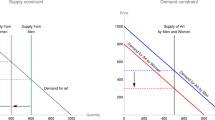Abstract
Considering leading Australian Indigenous artists, we investigate the role of an artist’s gender in the valuation of artworks. Our analysis shows that male and female artists work in different media and mediums and that both sale price and clearance rate differ by artist’s gender. Building on a descriptive analysis, the statistical analysis of the data using sample selectivity models and a Blinder–Oaxaca decomposition shows clear differences between the prices of artwork. We find that, accounting for differences in the characteristics of artworks and artists, the price of artworks by male Australian Indigenous artists is lower than that by female artists.

Similar content being viewed by others
Notes
Aboriginal avoidance practices in relation to sorry business (the term which refers to cultural practices and protocols associated with death) dictate that it is disrespectful to refer to a deceased person by their name for a period of time following their death.
References
Adams, R. B., Kräussl, R., Navone, M. A., & Verwijmeren, P. (2017). Is gender in the eye of the beholder? identifying cultural attitudes with art auction prices (SSRN Scholarly Paper No. ID 3083500). Rochester, NY: Social Science Research Network.
AIHW (2019). Deaths in Australia (Web Report No. PHE 229). Canberra, ACT: Australian Institute of Health and Welfare.
Artlandish (2019). The story of aboriginal art [WWW Document]. Artlandish Aboriginal Art Gallery. https://www.aboriginal-art-australia.com/aboriginal-art-library/the-story-of-aboriginal-art/. Retrieved September 19, 2019.
Ashenfelter, O., & Graddy, K. (2006). Art Auctions. In V. Ginsburgh & D. Thorsby (Eds.), Handbook of the economics of art and culture (pp. 909–945). Amsterdam: Elsevier.
Blinder, A. S. (1973). Wage discrimination: reduced form and structural estimates. The Journal of Human Resources, 8, 436–455.
Bocart, F., Gertsberg, M., & Pownall, R. A. J. (2018). Glass ceilings in the art market (SSRN Scholarly Paper No. ID 3079017). Rochester, NY:Social Science Research Network.
Cameron, L., Goetzmann, W. N., & Nozari, M. (2019). Art and gender: market bias or selection bias? Journal of Cultural Economics, 43, 279–307.
Cascone, S. (2019). A new study has simple advice for collectors looking for big returns on art: Invest in women. Artnet News. https://news.artnet.com/market/art-market-women-1615090. Accessed 16 Sept 2019
Eggelston, A. (2007). Indigenous art—Securing the Future. Australia’s Indigenous visual arts and craft sector (Commonwealth of Australia, Senate Report). Standing Committee on Environment, Communications, Information Technology and the Arts, Canberra, ACT.
Farrell, L., Fry, J. M., & Fry, T. R. L. (2018). Determinants of sales and price at auction for three Australian Indigenous artists: to pool or not to pool? Journal of Cultural Economics, 42, 507–520.
Farrell, L., & Fry, T. R. L. (2017). Pre-sale information and hammer prices for Australian Indigenous artists. Scottish Journal of Political Economy, 64, 483–500.
Fortin, N., Lemieux, T., & Firpo, S. (2011). Decomposition methods in economics. In O. Ashenfelter & D. Card (Eds.), Handbook of labor economics (pp. 1–1102). Amsterdam: Elsevier.
Halpirin, J. (2017). The 4 glass ceilings: how women artists get stiffed at every stage of their careers [WWW Document]. artnet News. https://news.artnet.com/market/art-market-study-1179317. Retrieved september 16, 19.
Heckman, J. J. (1976). The common structure of statistical models of truncation, sample selection and limited dependent variables and a simple estimator for such models. Annals of Economic and Social Measurement, 5, 475–492.
Heckman, J. J. (1979). Sample selection bias as a specification error. Econometrica, 47, 153–161.
Jann, B. (2008). The Blinder–Oaxaca decomposition for linear regression models. The Stata Journal, 8, 453–479.
Jeddi, H., & Malouche, D. (2015). Wage gap between men and women in Tunisia (arXiv.org, Quantitative Finance series No. 1511.02229), arXiv.org, Quantitative Finance series. Cornell University.
Johnson, T. (2006). When is a forgery not a forgery? Journal of Indigenous Policy, 6, 83–119.
Johnson, V. (2000). The “Aboriginal art scandals” scandal. Artlink, 20, 32–35.
Klein, M. (2019). The Market for Female Artists. Where do they outperform men? [WWW Document]. in other words. https://www.artagencypartners.com/is-there-demand-for-female-artists-at-auction/. Retrieved september 19, 2019.
Oaxaca, R. (1973). Male-female wage differentials in urban labor markets. International Economic Review, 14, 693–709.
Peterson, M. (2019). New technology, old ways? The gender price discount in online contemporary art auctions (Bachelor of Arts in Economics, Scripps Senior Theses. 1265). Claremont, California: Scripps College.
VanderWeele, T. J. (2013). A three-way decomposition of a total effect into direct, indirect and interactive effects. Epidemiology, 24, 224–232.
White, J. (2019). Gender representation in art pedagogy: A survey of student knowledge and attitudes around gender balance in art education (Master of Arts in Education, major thesis). Arcata: Humboldt State University.
Woodhead, A., & Acker, T. (2015). Productivity, income and gender: Aboriginal and Torres Strait Islander artists (No. Report Series # CR012), Cooperative Centre for Remote Economic Participation Research Report Series. Ninti One Limited, Alice Springs.
Author information
Authors and Affiliations
Corresponding author
Additional information
Publisher's Note
Springer Nature remains neutral with regard to jurisdictional claims in published maps and institutional affiliations.
This paper refers to deceased Indigenous artists by name. May their spirits find rest and peace as part of their lands, waters, spirits and all living things. This paper was completed whilst the last-named author was visiting Monash Business School, Department of Marketing, Monash University. We would like to thank the Australian Art Sales Digest for supplying the data used in this paper and note that responsibility for the information and views set out in this paper lies entirely with the authors.
Rights and permissions
About this article
Cite this article
Farrell, L., Fry, J.M. & Fry, T.R.L. Gender differences in hammer prices for Australian Indigenous art. J Cult Econ 45, 1–12 (2021). https://doi.org/10.1007/s10824-020-09382-4
Received:
Accepted:
Published:
Issue Date:
DOI: https://doi.org/10.1007/s10824-020-09382-4




